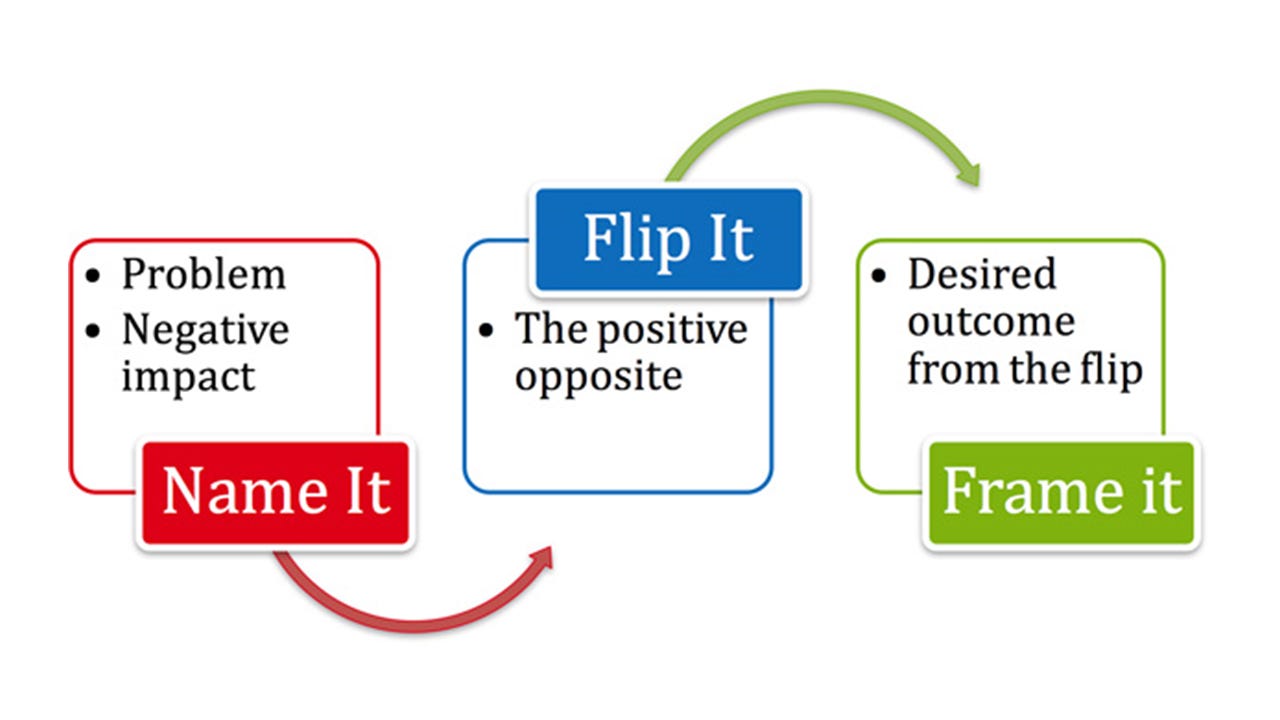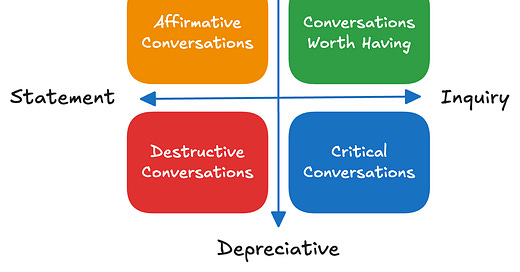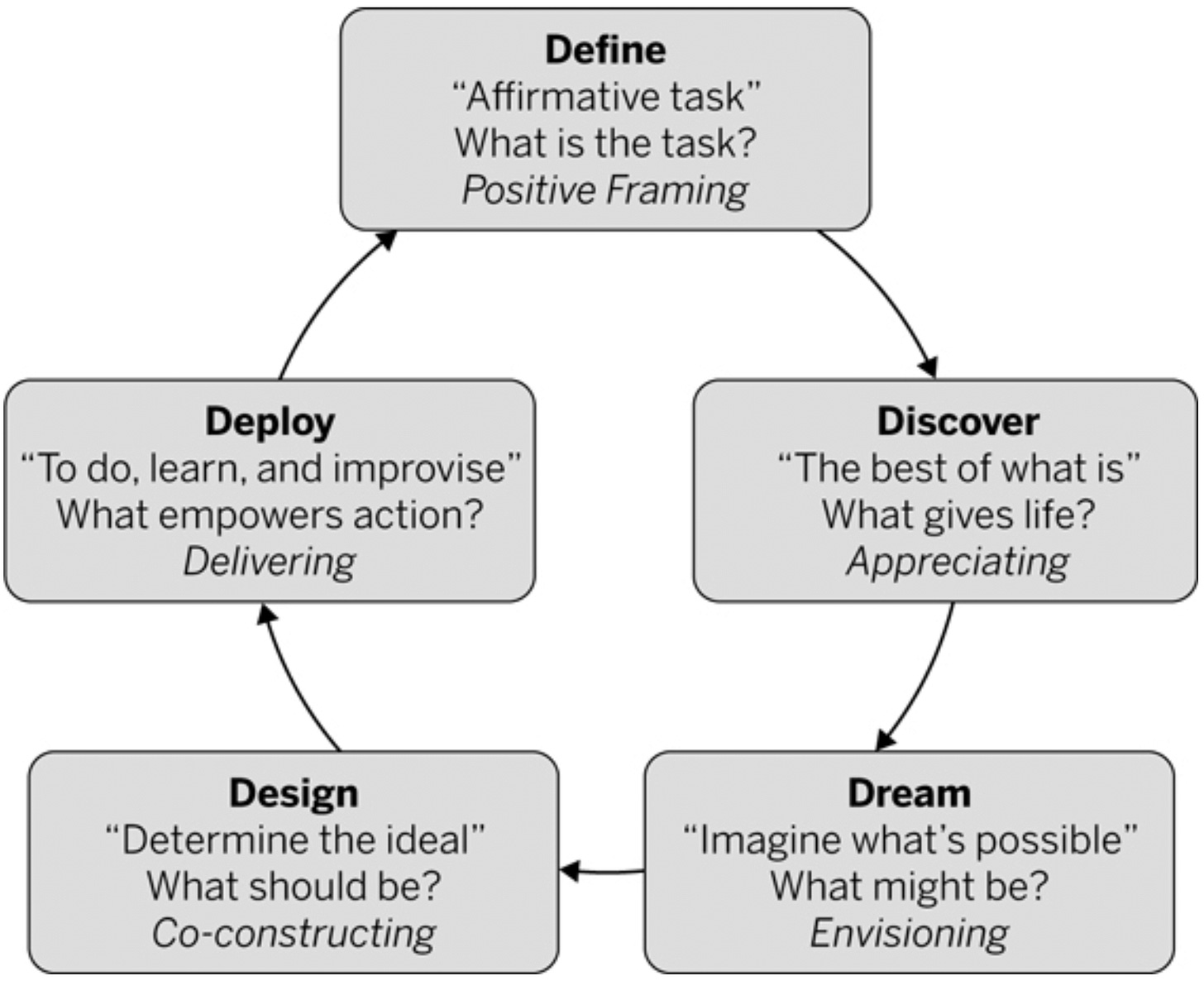Mastering AI for Human Flourishing
Appreciative Inquiry -- the other "AI" -- for transforming teams
Many year ago I was exposed to the practice of “Appreciative Inquiry” (AI) but the concepts did not stick! In recent years I have come to appreciate that transforming organizations occur by transforming self and interpersonal relationships by improving daily conversations and interactions.1 I started reading the book “Conversations Worth Having” by Jackie Stavros and Cheri Torres (“CWH book”).2
One day I was in a meeting with CDPH leadership discussing a difficult personnel issue and how to handle an individual. Susan Fanelli, Chief Deputy Director, gave some concrete and practical advice on how to reframe the issue with the employee. Susan took a problem, “named it,” “flipped it,” and “reframed it”! Wow! She effectively deployed Flipping — an AI practice described below. I have come to recognize Susan’s superpower — she is an AI master! This helps to explain why she is so revered and respected by staff, state officials, and locals across the state.
This conversation peaked my interest, and I returned to reading the CWH book with more intention. In this blog I am sharing what I learned. It’s a brilliant book which I highly recommend!
1 Four types of conversations
Conversations are the basis for transforming relationships, and in turn, transforming organizations. Conversations can be categorized using two dimensions. First, conversations can add value (appreciative) or devalue (depreciative). Second, conversations consists of questions (inquiry-based) or comments (statement-based). Using the appreciative-depreciative dimension and the inquiry-statement dimension, we can categorize conversations into four types (Figure 1).

Conversations Worth Having are conversations that add value through appreciative questions and dialogue.
Affirmative Conversations are conversations that add value through appreciative comments and statements.
Critical Conversations are conversations that devalue through depreciative questions and defensive interactions.
Destructive Conversations are conversations that devalue through depreciative comments and statements.
Our goal is to “live above the line”! Even better, spend most of your time in the right upper quadrant — Conversations Worth Having! This is AI — Appreciative Inquiry.
2 Three AI practices (theory of change)
The theory of change (Figure 2) for Conversations Worth Having is based on three connected practices that are interdependent, synergistic, and generative:
Tuning in
Positive framing
Generative questions
2.1 Tuning in
Tuning in is mindful awareness of self and others recognizing that the key drivers of our thoughts, emotions, and behaviors are from unconscious (“beneath the surface”) processes (Figure 3).
“When our conversations are below the line (depreciative), they generate stress, negative emotions and actions, and disconnection (refer to Figure 1). Similarly, when our body-mindset is below the line [in Figure 3] (we’re experiencing stress, negative emotions, and disconnection), we tend to foster depreciative conversations. If we don’t tune in and become aware, we can end up in a downward spiral that tears at the fabric of relationships and inhibits our capacity for well-being and success.”
“Conversely, when our conversations are above the line (appreciative), they generate connection, creativity, productivity, learning, and engagement. And when our body-mindset is above the line (we’re feeling connected, creative, and engaged), we tend to foster appreciative conversations. One key to intentionally fostering conversations worth having is to know where you are: above the line or below the line.”

Adapted from the CWH book (p. 57):
Tuning in requires us to listen deeply to our inner state and to others. Asking who’s in the driver’s seat applies to listening as well as speaking. When we just listen without an intention to listen deeply, what we hear is filtered and scripted by those drivers beneath our radar (Figure 3). This means we are at risk of listening with a closed mind, a closed heart, and a closed will. Our preconceived ideas, beliefs, and motivations may have us listening to find fault, judge, negate the other, or defend our point of view.
Being intentional about listening takes practice. It means listening with an open mind, willing to entertain another’s ideas; listening with an open heart, willing to empathize with another person’s experience and understand a situation from his or her point of view; and listening with an openness to new possibilities and new ways of going forward.
In preparation for listening deeply, you can do a quick one-minute emotional audit: “What am I thinking? What am I feeling? What do I want to happen now? What am I going to do next?”
Then choose to be present: pause, take a deep breath, center yourself, relax, and invite just a little more ________ (e.g., space, openness, light, compassion, curiosity, interest).
For tuning in, I cultivate these evidence-based practices:3
Quieting Ego (mindfulness; pause — breathe — get curious),
Managing Self (one’s thinking, emotions, and behaviors), and
Mindful, deep, reflective listening (Table 1).
Mindful awareness of what is known and unknown to self and others was popularized by the Johari Window (Figure 4). From Figure 3, we understand that what is unknown to self and others may not be readily accessible for psychological reasons. Therefore, to improve your baseline ability to tune in, seek regular feedback about what others know about you, and conduct experiments outside your comfort zone to learn about yourself. In short, expand the left upper quadrant in Figure 4.

2.2 Positive Framing
From the CWH book (p. 76):
“Positive framing is not specifically focusing on the positive, … It is about focusing attention and action on where we want to go or on what it is we want more of. … A positive frame opens the door for conversations that move us toward what everyone in the conversation wants. Such framing draws people in and inspires curiosity, imagination, and interest about moving toward a shared and desired outcome.”
Many of us pride ourselves on being effective “problem solvers.” For good reasons, high-performing organizations incentivize and reward this behavior. Consistently solving problems can lead to sustained continuous improvements. How can we use the science of positive psychology to make this even better? The answer — Flipping (Figure 5).

Step 1. Name it: What is the problem, complaint, challenge, or the thing you don’t want?
Step 2. Flip it: What is the positive opposite?
Step 3. Frame it: What is the positive impact if the flip were to be true? What is the desired outcome that everyone in the conversation wants?
Whether we focus on problems or not, inevitably, problems land on our lap or obstruct our path to our goals. We cannot ignore them. Addressing problems with our staff can feel like deficit-based micromanagement. Flipping reframes it into strength-based, solution-oriented problem-solving. This is game changing! We go beyond root-cause analysis of problems to include root-cause analysis of strengths and solutions — better known as theory of change.
Before a conversation, prepare by flipping issues or problems into a positive frame. During conversations, look for opportunities to practice flipping. In my experience, there is no shortage of opportunities to practice flipping.
2.3 Generative Questions
Generative questions are on based genuine curiosity and keeping an open mind and open heart. Generative questions can be categorized into four groups:
Make the invisible visible
Create shared understanding
Generate new knowledge
Inspire possibilities
Adapted from CWH book (p. 72)
Make the invisible visible: What don’t we know? What else might explain a person’s action or behaviors, besides what I am currently assuming? What hidden assumptions, beliefs, rules, or norms might be influencing our thinking? How might diverse expectations be influencing what’s possible? What is the experience that another is having, and how is it important in this moment? What’s the bigger context for this; how is it relevant? What’s taking up time and money? What exactly do we want to accomplish here?
Create shared understanding: What information or perspectives do others have that might add value? How do others understand or experience the situation? What is their story? How is this relevant to the work we are each doing? What future are we hoping for? How are individuals or departments going to be affected? What outcomes are desired? What does the client or customer actually want? What is essential and what might we let go of?
Generate new knowledge: How might current ways of thinking or configuring resources be getting in the way of innovation? What happens if ______? How might we combine your ideas with their data? How are all these data points linked; what’s the simplest explanation? How might the customer design this? How is the customer going to use this? How might we organize if we were starting from nothing? Where can we find people who are doing this well, and what can we learn from them?
Inspire possibilities: How might we create pathways forward that work for all? What have others done? Where is this already working well, and what can we learn from that? How might we ______? What if ______? How might we improve on the best of what is? What could we do if money and time were unlimited? How might we do this if we had to have a process in one hour?
Use generative questions to
elicit information, stories, ideas, and perspectives
tap experience
allow strengths to show up
surface best practices and elements of success
move toward solutions
move toward informative data
identify new ways of thinking, new possibilities, opportunities, and aspirations
inform what you might do, the results you might want
make room for new knowledge, creativity, and innovation
deepen connection
strengthen relationships
engage those on the sidelines
generate understanding
Summary
Conversations are the basis for transforming relationships, and in turn, transforming organizations. Conversations can add value (appreciative) or devalue (depreciative). Conversations consist of statements and inquiries. Appreciative inquiries lead to more engagement and discovery; ie, Conversations Worth Having. The power of AI/CWH is its simplicity.
There are four types of conversations (Figures 1 & 6):
Conversations Worth Having
Affirmative Conversations
Critical Conversations
Destructive Conversations
To promote Conversations Worth Having, use three AI practices (Figures 2 & 6):
Tuning in (eg, mindfulness)
Positive framing (eg, flipping)
Generative questions (eg, movement)
Appendix — Appreciative Inquiry
Appreciative inquiry was developed by professors at Case Western Reserve to counter the concern that “problem-solving” in organizations was deficit-based and could limit the potential for teams to discover, dream, design, and deploy more creative, positive, and sustainable future states.

A.1 The five AI Principles
The five AI principles are as follows (from CWH book):
Constructionist Principle: Understanding, interpersonal dynamics, meaning, and ultimately our social reality are created through language and in conversation. → What we believe to be true is informed by and evolves through conversation.
Simultaneity Principle: Change happens the moment a question is asked or a statement is made. → As words are spoken, our mind, body, and emotions react in a split second.
Poetic Principle: Every person, organization, or situation can be seen and understood from many perspectives. → There is no one truth about any person, situation, or organization; truth depends on perception and focus of attention.
Anticipatory Principle: The images and thoughts we hold influence our intention and conversation. → We move in the direction of the images and thoughts we hold. Our expectations inform what we look for, what we see, and what we hear.
Positive Principle: The more positive and generative the question, the more positive and long-lasting the outcome. → Our questions inspire images, and imagery compels action.
A.2 The AI 5-D Process
The AI 5-D cycle is a PDSA variant with a strong focus on planning.
Plan: Define, Discover, Dream Design
Do-Study-Act: Deploy (“do, learn, and improvise”)
B.1 Appreciative Inquiry resources
CWH (website: from the authors of CWH book)
The Center for Appreciative Inquiry (website)
Footnotes
See Figure 2 in: Tomás Aragón. Becoming a learning, healing, and impactful organization: The LHI model for transforming self, relationships, teams, and more. TeamPublicHealth, Aug 24, 2024. Available from: https://teampublichealth.substack.com/p/becoming-a-learning-healing-and-impactful
Jackie Stavros and Cheri Torres, Conversations Worth Having: Using Appreciative Inquiry to Fuel Productive and Meaningful Engagement, Second edition (Oakland, CA: Berrett-Koehler Publishers, Inc, 2022), https://www.conversationsworthhaving.today/store#section-1674342743697.
Edward D. Hess and Katherine Ludwig, Humility Is the New Smart: Rethinking Human Excellence in the Smart Machine Age, First edition (Oakland, CA: Berrett-Koehler Publishers, a BK Business book, 2017), https://www.bkconnection.com/books/title/Humility-Is-the-New-Smart.








I also took classes in Appreciative Inquiry and Conversations Worth Having. But wow, do they take practice! I guess all new habits do. When I am stuck I have to pull out my book and remind myself of the principles. Love that a thought leader like yourself would emphasize the value of staying curious as a way to find solutions. Looking forward to reading more in your substack. :)
A.2 The AI 5-D Process, I really liked this model. I plan to use this in team meetings as a visual — Thank you for sharing.